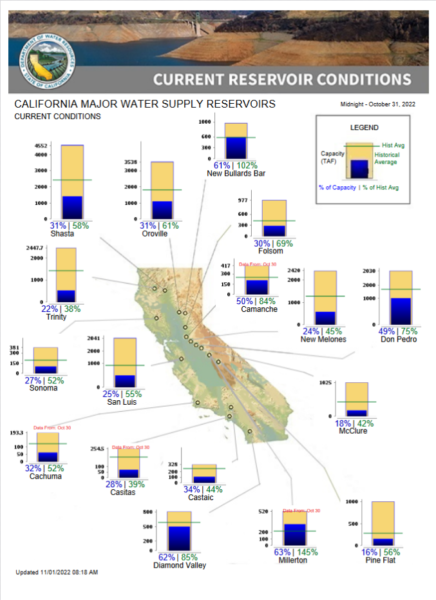A month into the new 2022-23 WY, not much has changed hydrologically for CVP/SWP reservoir storage. No measurable precipitation has occurred across the State and the EOY numbers from last month have simply continued to deplete Statewide carryover.
As of October 28th, total CVP reservoir storage was 3.36 million acre-feet (MAF), representing about 28% of total federal reservoir storage capacity. Relative to the 15-year average, however, current storage levels stand at 58%.
Current CVP reservoir storage for Shasta, Trinity, New Melones, Folsom and Millerton were 1.423, 0.536, 0.586, 0.294 and 0.326, respectively. Oroville Reservoir is currently storing about 1.123 MAF or 77% of its 15-year average for this date.
Interestingly, despite depressed water conditions across the State, only one reservoir (Trinity) ended the 2021-22 WY with storage below 50% of their 15-year average, although New Melones was close at 51%. Only Millerton was actually above their 15-year EOY average at 122%. Folsom Reservoir which enjoyed a “normal” WY, ended the WY with storage at 79% of their 15-year average. The reservoir, as many will recall, remained considerably above systemwide averages for much of the WY owing to its robust hydroclimatic season; but that benefit was quickly capitalized as CVOC relied heavily on Folsom Reservoir storage to provide delta inflow over and above many much larger CVP/SWP reservoirs for a good part of the irrigation season and summer months. Not surprisingly, Folsom’s storage was quickly depleted such that, by the EOY, it was storing 345,000 acre-feet, some 35% of total reservoir capacity (and representing only 79% of its longer-term average for EOY status).
For the month of October, through this past weekend, total Delta inflow has been averaging about 8,000 cfs per day. Sacramento River daily flows at Freeport have been averaging just under 6,800 cfs.
Total delta exports have been continually ratcheted down over the month, with 3-days last week under 1,000 cfs. Overall daily average exports for the month are about 1,600 cfs, compared to about 2,400 cfs at the beginning of the month. Not surprisingly, the E/I ratio average for the month of October has been only 19%.
November is shaping up to be an early indicator of how the 2022-23 WY will fare. For northern California at least, we do have a week of periodic (to steady?) shower activity forecast. Unlike past years, however, California does not have an established deep carryover reserve in our reservoirs to see us through should precipitation fall short of projections. There is no doubt here; we need substantive refill in all federal/State reservoirs.
There are conflicting projections about what the 2022-23 fall-winter season will ultimately hold for California. Most however, agree that we will have to endure a third consecutive La Niña condition in some form, with its characteristic above normal temperatures, strong likelihood of reduced precipitation, and prolonged drought risks.
FOR MORE INFORMATION
Reservoirs
- Daily Reservoir Summary
- Selected Reservoirs, Daily Graphs (interactive)
- CA Data Exchange Center: Reservoirs
- CVP Daily Water Supply Report
Precipitation
- Real-time Rainfall Maps
- Detailed Monthly Precipitation Summary for Water Year
- Center for Western Weather and Water Extremes (CW3E)
Snow
Full Natural Flow Data
Drought/Climate
Water Project Operations
- State Water Project Operations and Delta Status
- Central Valley Project Operations
- Lower Colorado River Operations
Delta conditions
- Bay-Delta Live (Real Time Delta Conditions)
- EcoAtlas (Delta Restoration Projects)
Specialty Portals
- My Water Quality (CA Water Quality Monitoring Council)
- Fish Surveys (Department of Fish and Wildlife)
- NASA GRACE Groundwater and Soil Moisture Conditions



